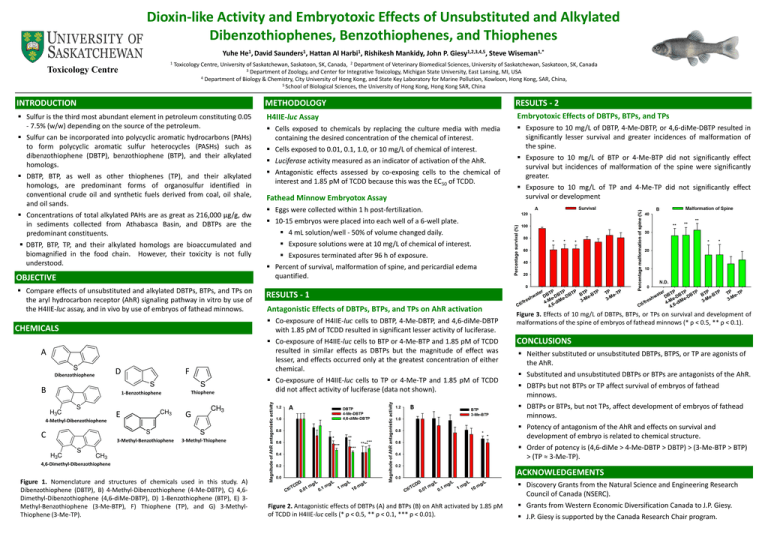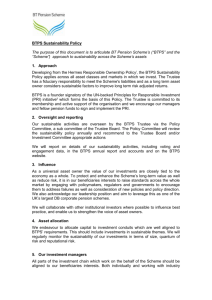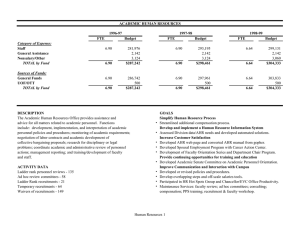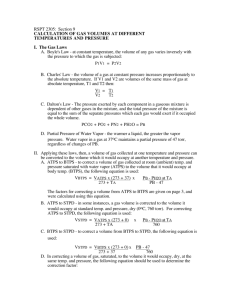Dioxin-like Activity and Embryotoxic Effects of Unsubstituted and Alkylated
advertisement

Dioxin-like Activity and Embryotoxic Effects of Unsubstituted and Alkylated Dibenzothiophenes, Benzothiophenes, and Thiophenes Yuhe He1, David Saunders1, Hattan Al Harbi1, Rishikesh Mankidy, John P. Giesy1,2,3,4,5, Steve Wiseman1,* 1 Toxicology Centre Toxicology Centre, University of Saskatchewan, Saskatoon, SK, Canada, 2 Department of Veterinary Biomedical Sciences, University of Saskatchewan, Saskatoon, SK, Canada 3 Department of Zoology, and Center for Integrative Toxicology, Michigan State University, East Lansing, MI, USA 4 Department of Biology & Chemistry, City University of Hong Kong, and State Key Laboratory for Marine Pollution, Kowloon, Hong Kong, SAR, China, 5 School of Biological Sciences, the University of Hong Kong, Hong Kong SAR, China INTRODUCTION METHODOLOGY RESULTS - 2 Sulfur is the third most abundant element in petroleum constituting 0.05 - 7.5% (w/w) depending on the source of the petroleum. H4IIE-luc Assay Embryotoxic Effects of DBTPs, BTPs, and TPs Cells exposed to chemicals by replacing the culture media with media containing the desired concentration of the chemical of interest. Exposure to 10 mg/L of DBTP, 4-Me-DBTP, or 4,6-diMe-DBTP resulted in significantly lesser survival and greater incidences of malformation of the spine. Sulfur can be incorporated into polycyclic aromatic hydrocarbons (PAHs) to form polycyclic aromatic sulfur heterocycles (PASHs) such as dibenzothiophene (DBTP), benzothiophene (BTP), and their alkylated homologs. DBTP, BTP, as well as other thiophenes (TP), and their alkylated homologs, are predominant forms of organosulfur identified in conventional crude oil and synthetic fuels derived from coal, oil shale, and oil sands. Concentrations of total alkylated PAHs are as great as 216,000 µg/g, dw in sediments collected from Athabasca Basin, and DBTPs are the predominant constituents. DBTP, BTP, TP, and their alkylated homologs are bioaccumulated and biomagnified in the food chain. However, their toxicity is not fully understood. OBJECTIVE Compare effects of unsubstituted and alkylated DBTPs, BTPs, and TPs on the aryl hydrocarbon receptor (AhR) signaling pathway in vitro by use of the H4IIE-luc assay, and in vivo by use of embryos of fathead minnows. Cells exposed to 0.01, 0.1, 1.0, or 10 mg/L of chemical of interest. Luciferase activity measured as an indicator of activation of the AhR. Antagonistic effects assessed by co-exposing cells to the chemical of interest and 1.85 pM of TCDD because this was the EC50 of TCDD. Fathead Minnow Embryotox Assay A D F B E G Exposure to 10 mg/L of TP and 4-Me-TP did not significantly effect survival or development Eggs were collected within 1 h post-fertilization. 10-15 embryos were placed into each well of a 6-well plate. 4 mL solution/well - 50% of volume changed daily. Exposure solutions were at 10 mg/L of chemical of interest. Exposures terminated after 96 h of exposure. Percent of survival, malformation of spine, and pericardial edema quantified. RESULTS - 1 Antagonistic Effects of DBTPs, BTPs, and TPs on AhR activation Co-exposure of H4IIE-luc cells to DBTP, 4-Me-DBTP, and 4,6-diMe-DBTP with 1.85 pM of TCDD resulted in significant lesser activity of luciferase. CHEMICALS Exposure to 10 mg/L of BTP or 4-Me-BTP did not significantly effect survival but incidences of malformation of the spine were significantly greater. Co-exposure of H4IIE-luc cells to BTP or 4-Me-BTP and 1.85 pM of TCDD resulted in similar effects as DBTPs but the magnitude of effect was lesser, and effects occurred only at the greatest concentration of either chemical. Co-exposure of H4IIE-luc cells to TP or 4-Me-TP and 1.85 pM of TCDD did not affect activity of luciferase (data not shown). A B Figure 3. Effects of 10 mg/L of DBTPs, BTPs, or TPs on survival and development of malformations of the spine of embryos of fathead minnows (* ρ < 0.5, ** ρ < 0.1). CONCLUSIONS Neither substituted or unsubstituted DBTPs, BTPS, or TP are agonists of the AhR. Substituted and unsubstituted DBTPs or BTPs are antagonists of the AhR. DBTPs but not BTPs or TP affect survival of embryos of fathead minnows. DBTPs or BTPs, but not TPs, affect development of embryos of fathead minnows. Potency of antagonism of the AhR and effects on survival and development of embryo is related to chemical structure. C Order of potency is (4,6-diMe > 4-Me-DBTP > DBTP) > (3-Me-BTP > BTP) > (TP ≈ 3-Me-TP). Figure 1. Nomenclature and structures of chemicals used in this study. A) Dibenzothiophene (DBTP), B) 4-Methyl-Dibenzothiophene (4-Me-DBTP), C) 4,6Dimethyl-Dibenzothiophene (4,6-diMe-DBTP), D) 1-Benzothiophene (BTP), E) 3Methyl-Benzothiophene (3-Me-BTP), F) Thiophene (TP), and G) 3-MethylThiophene (3-Me-TP). ACKNOWLEDGEMENTS Discovery Grants from the Natural Science and Engineering Research Council of Canada (NSERC). Figure 2. Antagonistic effects of DBTPs (A) and BTPs (B) on AhR activated by 1.85 pM of TCDD in H4IIE-luc cells (* ρ < 0.5, ** ρ < 0.1, *** ρ < 0.01). Grants from Western Economic Diversification Canada to J.P. Giesy. J.P. Giesy is supported by the Canada Research Chair program.







